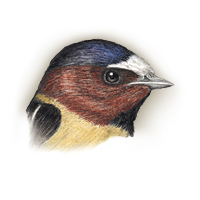 |
Cliff Swallow
Petrochelidon pyrrhonota |
|
|
STANFORD LOCATIONS: Common resident from spring through fall, foraging aerially throughout campus. Large colonies in the Main Quad comprise most of the campus's breeding population, although a few pairs build their mud nests on residences and other structures. Nests are occasionally appropriated by House Sparrows. |
 |
Location |
Type |
Mating System |
Parental Care |
2ndary Diet |
Strategy |
|
|
I: 14-16 DAYS ALTRICIAL |
|
|
||
|
BUILDING 3 feet + |
|
(3-6) MONOG |
MF |
| BREEDING: | Open country, savanna, esp near running water. Usu 1, occ 2-3 broods. |
| DISPLAYS: | Courtship flight followed by cop on ground. |
| NEST: | Plastered on underside of bridge or culvert, on cliff, wall under eaves, or other vertical surface; of mud pellets, tubular entrance to a spherical cavity sparsely lined with grass, feathers. Built in 5-14 days. Often repaired and reused. |
| EGGS: | White, creamy, or pinkish white, spotted with brown. 0.8" (20 mm). |
| DIET: | Almost entirely insects, but occ gorge on berries. |
| CONSERVATION: | Winters in S.A. from Paraguay and c and s e Brazil, S to c Argentina. Blue List 1976-77, 1981, Special Concern 1982, Local Concern, 1986; status unclear in n e. Rare cowbird host. House Sparrows usurp nests. |
| NOTES: | Nest in colonies, occ to >1,000 pairs. Colonies serve as information centers for good foraging spots: unsuccessful foragers observe successful foragers feeding nestlings and follow them from colony. Colony site occ alternated between years to avoid heavy infestations of nest parasites. Mutual vocal recognition between parents and offspring occurs shortly before fledging. Occ forage with Barn Swallows. |
| ESSAYS: | Parasitic Swallows; Parent-Chick Recognition; Coloniality; Blue List; Disease; Masterbuilders. |
| REFERENCES: | Beecher et al., 1985; Brown, 1986; Brown and Brown, 1986; Withers, 1977. |
| Help | Abbreviations | Species-Alphabetical | Species-Taxonomic | Essays-Alphabetical | |
| Except for Stanford Locations, the material in this species treatment is taken, with permission, from The Birder's Handbook (Paul Ehrlich, David Dobkin, & Darryl Wheye, Simon & Schuster, NY. 1988). | |||||